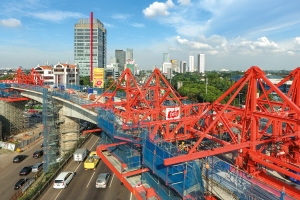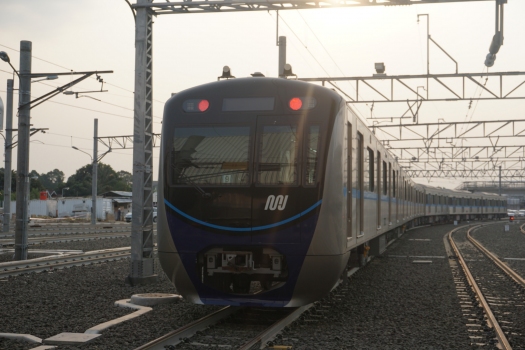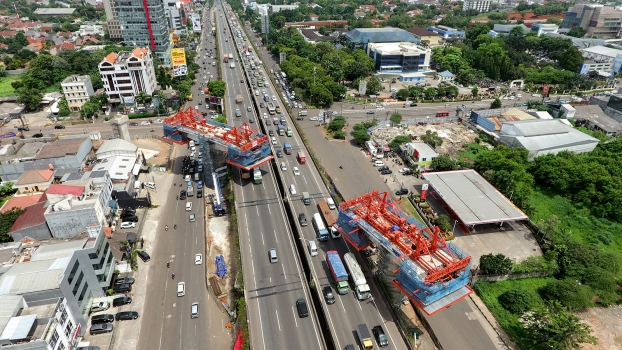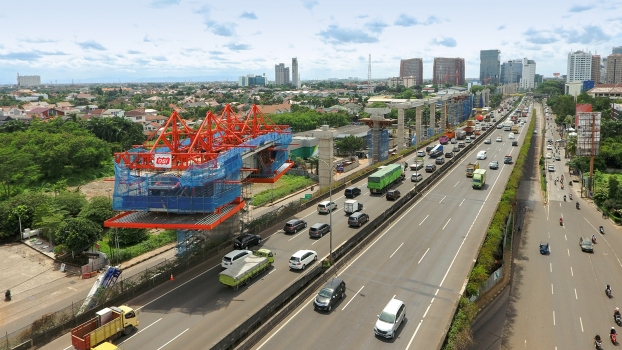General Information
| Name in local language: | MRT Jakarta |
|---|---|
| Other name(s): | Jakarta Mass Rapid Transit |
| Completion: | 24 March 2019 |
| Status: | in use |
Project Type
| Function / usage: |
Metro or rapid transit system |
|---|
Location
| km | Name |
Technical Information
Dimensions
| number of stations | 13 | |
| system length | 15.7 km | |
| maximum speed | 80 - 100 km/h | |
| track gauge | 1 067 mm | |
| number of lines | 1 |
Case Studies and Applied Products

MRT Jakarta: Indonesia’s first Light Rail Project
The large scale Mass Rapid Transit (MRT) project in Jakarta is the first light rail project in Indonesia and is expected to significantly reduce traffic congestion. In 2013, the first, approx. 16 km long section of the North-South Corrid ... [more]
Excerpt from Wikipedia
The Jakarta Mass Rapid Transit (Indonesian: Moda Raya Terpadu Jakarta[a]) or Jakarta MRT (MRT Jakarta, stylized as mrt jakarta) is a rapid transit system in Jakarta, the largest metropolis of Indonesia.
The system is operated by PT Mass Rapid Transit Jakarta (Perseroda), a municipally owned perseroan terbatas of the city of Jakarta. Phase 1 of the project (Lebak Bulus to Bundaran HI) was officially opened on 24 March 2019.
History
Jakarta is the main financial hub and largest city of Indonesia, harbouring 10 million inhabitants, one-third of the population of Greater Jakarta. It is estimated that over four million residents of the surrounding Greater Jakarta area commute to and from the city each working day. Transport issues are attracting increasing political attention with a government goal of increasing the number of trips using public transport to 60% by 2030.
Impending gridlock and stall
The idea of MRT construction in Jakarta has been sparked since 1985 by the then Head of the Agency for the Assessment and Application of Technology, B.J. Habibie. The BPPT said that population growth in Jakarta declined between 1985 and 1990. However, the growth of Jakarta's satellite cities was high so that the mobility of residents from the capital to Bodetabek was very large. The roads in Jakarta will no longer be able to accommodate the mobility of the population. Therefore, a mode of transport is needed that accommodates the mobility of people from the Bodetabek area.
As of 2010, public transportation in Jakarta served only 56% of commuter trips. This figure must be increased again considering the high growth of the vehicle population. The average growth of motorised vehicles in Jakarta was 9.5%, while the growth of road length only reached 0.1% between 2005 and 2010. This must be addressed with a policy to reduce and prevent severe congestion. Until then, public transportation in the city mainly consists of the TransJakarta bus rapid transit system, the KRL Commuterline commuter rail, and various types of independent buses; starting from the very small bemo and pickup-truck sized mikrolet, to slightly larger minibuses such as the widely used MetroMini and Kopaja minibuses and full sized city buses. There are also both two and four wheeled taxis.
In 1996, President Soeharto's administration set out to build the Jakarta MRT with a 14 km Blok M‒Stasiun Jakarta Kota route, fully built underground. However, this endeavour failed due to the 1997‒1998 economic crisis. In 2000, the project was resumed after Indonesia's socio-political and economic conditions improved. At that time, the Study on Integrated Transportation Master Plan for Jabodetabek (SITRAMP) phase I was initiated. The main points of SITRAMP I were the reassessment of the MRT project of Fatmawati‒Monas route and the installation of the concept for SITRAMP II. At the request of the Government of Indonesia, JICA was entrusted by the Government of Japan to undertake the SITRAMP II study which lasted from November 2001 to March 2004. JICA offered the Fatmawati‒Monas route with several alternative construction designs to the government which were obtained after conducting a feasibility study. However, efforts to build the MRT were only resumed in 2005. President Susilo Bambang Yudhoyono designated the Jakarta MRT as a national project. From this designation, the preparatory processes for the construction of the first line of the Jakarta MRT began. The Japanese government also agreed to provide a loan for this national project.
First development
The process of developing the first line of the Jakarta MRT began when President SBY designated the system as a national project. In November 2006, the first loan agreement was signed with JICA for the MRT project. The agreement includes study funding and construction work funding for the first MRT line. On 17 June 2008, the DKI Jakarta Government established PT MRT Jakarta as a regional-owned enterprise company to support the construction and operation of the Jakarta MRT.
The basic design work of this first line was carried out from 2010 to 2012. On 26 April 2012, the declaration of the preparation of the Jakarta MRT North-South Line project was carried out by then DKI Jakarta Governor, Fauzi Bowo. A year later, on 11 June 2013, the first three project contracts were signed, namely the underground track construction. Meanwhile, the contract for the elevated track was signed on 10 October 2013. This event was held in conjunction with the laying of the first stone to mark the start of construction by the new Governor, Joko Widodo.
Construction of the entire line was fully completed on 31 October 2017. Starting 12 March 2019, the line was opened to the public in a limited public trial that lasted until just before the inauguration. The first line of the Jakarta MRT was officially operated on 24 March 2019 after being inaugurated by President Joko Widodo.
Continued development
At the same time as the inauguration of the first phase of the North-South Line, President Joko Widodo also launched the construction of the second phase of the North-South Line. The construction process of this second phase, especially phase II-A (Bunderan HI‒Kota Tua), is considered to be late from the target. This is due to the Covid-19 pandemic which affects the budget and the contract auction process. As a result, there are several contract packages that are combined and carried out by direct procurement. The first segment construction target, which was originally completed in 2024, is believed to be delayed until 2025. To date, the construction process for this phase is still ongoing. Unlike the previous phase, this second phase has been designed to be built with the concept of a transit-oriented area, making it easier for users to switch modes of transport. Meanwhile, phase II-B (Kota Tua‒Ancol) is still under feasibility study.
According to the JABODETABEK Urban Transportation Policy Integration Phase (JUTPI) report, the Jabodetabek transportation master plan (RITJ) will eventually form 10 MRT routes, which by 2035 will consist of:
- MRT 01 Lebak Bulus-Kampung Bandan (2024) - the North–South Line.
- MRT 02 Balaraja-Cikarang (From 2029 the initial phase of Ujung Menteng Kalideres) - the East–West Line which has undergone changes so that it passes through the Ujung Menteng-Tomang segment.
- MRT 03 Kota-SHIA (2029) - passes Pluit and PIK.
- MRT 04 Lebak Bulus-Cawang-Cilincing.
- MRT 05 Karawaci-Cikarang Selatan (From 2029, Halim-Joglo).
- MRT 06 Lebak Bulus-Rawa Buntu-Karawaci.
- MRT 07 North Bekasi-South Bekasi.
- MRT 08 Pluit-Grogol-Kuningan-Depok (From 2029, Pluit-Cilandak).
- MRT 09 MRT Outer Ring Line (2034) - from Kamal to Cilincing following the Fatmawati-TMII route
- MRT 10 MRT Inner Ring Line.
Meanwhile, according to the DKI Jakarta Provincial Government on 12 November 2021 live at the Jakarta Investment Forum (JIF), the Railway Masterplan 2039 (Concept of DKI Jakarta Transportation Masterplan) will be divided into two based on ownership status.
The first is the DKI Jakarta Provincial Government Urban Railway with 14 lines consisting of two MRT lines, six LRT lines and six "Jakarta Urban Railway" lines or PPJ for short. This PPJ is the benchmark for the route that will later be used for rail transportation in the future, which can use any means of rail transportation such as trams, LRTs or MRTs. Meanwhile, the second is the Central Government Railway with the Jabodebek LRT, KRL Commuterline (with the development of Jatinegara-Manggarai-Tanah Abang-Duri-Angke-Kampung Bandan-Jatinegara into an Elevated Loopline), and the Jakarta-Bandung high-speed train
The routes belonging to the DKI Jakarta Provincial Government are:
- 01. MRT Lebak Bulus-Ancol Barat - the North–South Line.
- 02. MRT Ujung Menteng-Meruya Utara - the East–West Line, which has undergone changes so that it passes through the Ujung Menteng-Tomang segment and is also extended with the Ujung Menteng-Cikarang and Tomang-Balaraja segments
- 03. LRT Pegangsaan Dua-Velodrome
- 04. LRT Kelapa Gading-JIS
- 05. LRT Velodrome-Klender
- 06. LRT JIS-Rajawali
- 07. LRT Klender-Halim
- 08. LRT Pulogebang-Joglo
- 09. PPJ Rajawali-Pesing
- 10. PPJ Pesing-Rubber
- 11. PPJ Pulogebang-JIS - Possibly becoming part of the MRT Outer Ring Line
- 12. PPJ Lebak Bulus-PIK - Possibly becoming part of the MRT Outer Ring Line
- 13. PPJ JIS-PIK - Possibly becoming part of the MRT Outer Ring Line
- 14. PPJ Fatmawati-TMII - Confirmed to be the phase 4 of the MRT as part of the MRT Outer Ring Line
Apart from that, South Korea's Hyundai Rotem offers an alternative Outer Ring Line route from Rawa Buaya to Ujung Menteng via Kembangan Station (Integration with the MRT East-West Line), Tanah Kusir Station (integration with the new station on the KRL Rangkasbitung Line), Fatmawati (Integration with the MRT North-South Line), then follow the Fatmawati-TMII route, then continuing back to Cikunir Station (integration with the LRT Jabodebek Bekasi Line), Cakung Station (Integration with the KRL Cikarang Line), and Ujung Menteng Station (Integration with the MRT East-West Line).
Funding
Phase 1
Phase 1 of the project was funded through a soft loan (Rp16 trillion) (US$1.2 billion) from the Japan International Cooperation Agency (JICA) with a 30 years tenure and 0.25% interest per annum. The loan number IP is 536 (signed November 2006) for engineering services. The engineering services loan is a pre-construction loan to prepare the construction phase. It consists of:
- Basic Design package, managed by the DGR (Directorate General of Railways, Ministry of Transport)
- Management and Operation package, managed by the Bappeda (Jakarta Regional Planning Board)
- Construction assistance in tender, managed by the PT MRT Jakarta
Phase 2
Phase 2 was funded through a similar loan scheme with a 40 years tenure, allowing a 10 years grace period. The first stage of phase 2 funding (Rp9.4 trillion) incurred 0.1% interest per annum. Phase 2A funding (Rp25 trillion) will cover a portion of phase 1 excess expenditure (Rp2.5 trillion).
On 24 August 2022, it was announced that the cost required for Phase 2A has been adjusted to Rp26 trillion (US$1.7 billion), up from Rp22.5 trillion. The challenging soil conditions were cited as the reason for the increase.
Phase 3
Phase 3 will be funded by a Japanese investor, in January 2023 it was announced that cost required for Phase 3 is Rp160 trillion (US$10.6 billion). It will connect Balaraja and Cikarang.
Phase 4
Phase 4 will be funded by a South Korean consortium led by Korea Overseas Infrastructure and Urban Development Corporation with estimates cost Rp28 trillion (US$1.9 billion).
System network
The Jakarta MRT is expected to stretch across over 108 kilometres (67 mi), including 26.7 kilometres (16.6 mi) for the Red line (from Lebak Bulus to Ancol) and 87 kilometres (54 mi) for the Yellow line (from Cikarang to Balaraja). Trains run on the right to match Indonesian railways, which also have a right handed traffic, despite Indonesia has a left handed traffic for roads.
North–South line
Phase 1
Phase 1 connects Lebak Bulus to Bundaran HI along 15.7 kilometres (9.8 mi) and consists of 13 stations (7 elevated stations and 6 underground stations). The Indonesian Ministry of Transport approved this plan in September 2010 and invited tenders. Construction began in October 2013.
Phase 1 was opened for free service on 24 March 2019. Commercial service began on 1 April 2019. Phase 1 is expected to serve 212,000 passengers per day. This expected capacity may be maxed out to 960,000 per day. The 15.7 kilometres (9.8 mi) distance is covered in under 30 minutes. Within its first month of operations, 82,000 passengers used the line daily.
Phase 2
Phase 2 was initially planned to extend Bundaran HI to Kampung Bandan in North Jakarta. However, land acquisition issues hindered the process, prompting the administration to find an alternative location, which will also be designed to house the train depot.
On 1 January 2019, the president director of MRT Jakarta, William Sabandar said the city administration had decided to make Kota the final station for Phase 2. The extension was then renamed to Phase 2A.
Phase 2A will extend the Red line northwards, from Bundaran HI to Kota and consists of 7 stations over 5.8 kilometres (3.6 mi). The extension was initially planned to be fully operational by March 2026. However, due to problems securing bidders for the construction and the effects of the COVID-19 pandemic, the extension is now targeted to be fully operational by 2028.
On 20 February 2019, it was announced that the Red line will be extended further, towards Ancol. The extension was named Phase 2B.
On 17 February 2020, during the signing of contract CP201 for the construction of the first two stations of the Phase 2A extension, the administration announced that Phase 2B will consist of two stations and one depot, and was under feasibility studies, with its construction expected to commence in mid-2022. It has since been delayed. Phase 2B is estimated to cost Rp10 trillion.
Phase 2A construction started on 22 March 2021. During excavation works for the construction of Phase 2A, the remains of tracks used for Jakarta's tramway were found.
East–West line (planned)
East–West line Legend planned line to Balaraja Kembangan Meruya Kedoya Kebon Jeruk Tanjung Duren Arjuna Tomang Grogol Roxy Petojo Tanah Abang Cideng Thamrin/Sarinah Kebon Sirih Gondangdia Kwitang Senen Pasar Senen Galur Cempaka Putih Sumur Batu Pulomas Kelapa Gading Barat Kelapa Gading Timur Perintis Pulo Gadung Penggilingan Cakung Barat Pulo Gebang Ujung Menteng planned line to CikarangThis diagram:
- view
- talk
- edit
The East–West Line is the second MRT Jakarta line which connects Cikarang in the east with Balaraja in the west via the Central Jakarta area. This line is planned to have 48 stations and a length of approximately 84,102 to 87 km with funding requirements of IDR 160 trillion. Just like the North-South line, the East-West line will also be built in phases, 3A and 3B. The line is planned to interchange with the North-South line at Thamrin Station. It is currently under architectural design studies and construction was initially expected to begin in 2020, however it has since been delayed and is now targeted to begin in 2024.
Phase I
Phase I is the initial stage of construction of the East–West Line, divided into two stages. Initially, it was planned to stretch for 31.7 km connecting Ujung Menteng with Kembangan. Later, it was revised to connect Medan Satria with Tomang first for phase 3 stage 1, stretching 24.5 km, and then Kembangan with Tomang for phase 3 stage 2, stretching 9.2 km. Phase 3 Stage 1 will be funded by Japan International Cooperation Agency (JICA), after an agreement was signed on 13 May 2024.
Phase II
Phase II itself will initially have 22 stations, with 14 stations in the Balaraja-Karangtengah segment and 8 stations in Medan Satria-Cikarang segment. Later, the construction of the western segment of the line was revised to Balaraja-Kembangan, while the eastern segment remains the same, with total length of 50.4 km of line to be constructed.
Outer–Ring Line (planned)
In December 2020, the President Director of MRT Jakarta, William Sabandar, announced plans for the construction of Phase 4. This line will connect Fatmawati with Taman Mini Indonesia Indah for approximately 12 km. This route is considered the most strategic route because there is no rail transportation that passes through this area. Apart from that, this route is planned to be integrated with the Kampung Rambutan Bus Terminal, Tanjung Barat Station (KRL Bogor Line), and the Jabodebek LRT (Cibubur Line). Currently the process has begun for a feasibility study and then a design planning process is carried out. This phase of construction is planned to use the Government Cooperation with Business Entities (KPBU) scheme. It is planned that this line will be built starting in 2025.
Rolling stock
Contract CP 108 for the procurement of rolling stock for the Jakarta MRT was awarded to a consortium led by Sumitomo Corporation on 3 March 2015. A total of 16 six-cars trainsets were ordered at a cost of ¥10.8 billion (Rp145 billion). The trains were built in Nippon Sharyo's plant in Toyokawa, Aichi.
Each car measures 20 m (65 ft 7 in) in length, 2.9 m (9 ft 6 in) in width, and 3.9 m (12 ft 10 in) in height. These trains utilize the CBTC signaling system and are equipped with Automatic Train Operation (ATO) GoA 2, with drivers operating the doors and driving in case of emergency. Like the KRL Commuterline, the MRT trains are also powered via overhead catenary.
MRT Jakarta officially call the trains Ratanggas (singular Ratangga), a nickname first bestowed on 10 January 2018 by then Governor of Jakarta, Anies Baswedan. The name, which is Old Javanese for chariots, was derived from Mpu Tantular's Kakawin Sutasoma (also the source for Indonesia's national motto). It offers a women-only carriage during morning peak hours from 7AM to 9AM and in the afternoon from 5PM to 7PM.
Text imported from Wikipedia article "Jakarta MRT" and modified on July 10, 2024 according to the CC-BY-SA 4.0 International license.
Participants
Currently there is no information available about persons or companies having participated in this project.
Relevant Web Sites
Relevant Publications
- (2020): Circular lining behaviour due to earthquake load in MRT Jakarta underground tunnel area CP-106. In: IOP Conference Series: Materials Science and Engineering, v. 930, n. 1 (1 September 2020), pp. 012037.
- (2021): Design of Jakarta Mass Rapid Transit package CP103. Presented at: IABSE Congress: Structural Engineering for Future Societal Needs, Ghent, Belgium, 22-24 September 2021, pp. 1249-1257.
- (2006): Underground space use approach in Indonesia Jakarta mass rapid transit project case study. In: Tunnelling and Underground Space Technology, v. 21, n. 3-4 (May 2006), pp. 466.
- About this
data sheet - Structure-ID
20076553 - Published on:
14/01/2019 - Last updated on:
08/07/2024









